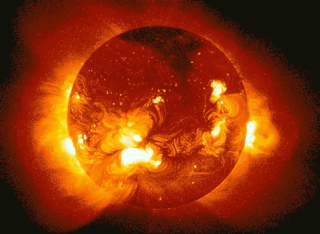

| Visitors Now: | |
| Total Visits: | |
| Total Stories: |

| Story Views | |
| Now: | |
| Last Hour: | |
| Last 24 Hours: | |
| Total: | |
Chet Raymo, “That Savage of Fire, That Seed…”
Thursday, March 14, 2013 21:17
% of readers think this story is Fact. Add your two cents.
“That Savage of Fire, That Seed…”
by Chet Raymo
“Let me say this as simply as I can. The Sun, like the universe, is mostly hydrogen. An atom of hydrogen is a single proton and a single electron, bound together. The center of the Sun is so hot – half-a-million miles of overbearing matter – that the electrons and protons can’t hold together (try holding hands in a surging, tumultuous crowd), so what you have is a hot soup – a plasma – of protons and electrons, flailing about independently. The electrical force between like charges is repulsive, so every time two protons approach each other they swerve away. But protons are also subject to the strong nuclear force, which is attractive, and stronger than the electrical force at very close range. Normally, if two protons approach each other, they are repelled before they get close enough for the strong nuclear force to kick in.
But now heat up the soup. The protons whiz about faster. If they are moving fast enough, they can approach closely enough for the strong nuclear force to bring them crashing together. Fusion. How hot? About 10 million degrees, which is the sort of temperature you’d find at the center of the Sun. When two protons combine, one flings off its positive charge and becomes a neutron. Then the proton-neutron pair combines with another proton to form a helium-three nucleus – two protons and a neutron – which quickly unites with another of the same and throws off two protons to become a helium-four nucleus – two protons and two neutrons. Got that? Hydrogen is fused into helium. The ejected positive charges go off as positrons (antielectrons), which meet up with electrons in the soup and annihilate. (There are neutrinos involved too, but let’s ignore them.)
Now for the bookkeeping. Add up the mass of the original particles in each interaction – six protons and two electrons – and add up the mass of the final particles – a helium-four nucleus and two protons. After the orgy of combination, some mass is missing! For each individual interaction as just described the amount of missing mass is miniscule, but in the seething caldron that is the Sun’s core it amounts to four billion kilograms of vanished mass every second. Hardly missed by our star – like a thimbleful of water dipped from the ocean – but for the Earth it is the difference between day and night. Hydrogen has been turned into helium and the vanished mass appears as energy. A lot of energy. The famous Einstein equation: Energy equals mass times the speed of light squared.
The star shines! The universe blazes with light and life.
And, knowing this – and just think what a thing it is that we know it – how is it that we whine and carp and glower? How is it that we snipe and cavil and rue our fates and that of the world? Wallace Stevens answers ironically in his poem “Gubbinal,” smothers us in irony actually:
“That strange flower, the sun,
Is just what you say.
Have it your way.
The world is ugly,
And the people are sad.
That tuft of jungle feathers,
That animal eye,
Is just what you say.
That savage of fire,
That seed,
Have it your way.
The world is ugly,
And the people are sad.”
- http://blog.sciencemusings.com/
2013-03-14 21:15:39
Source:



